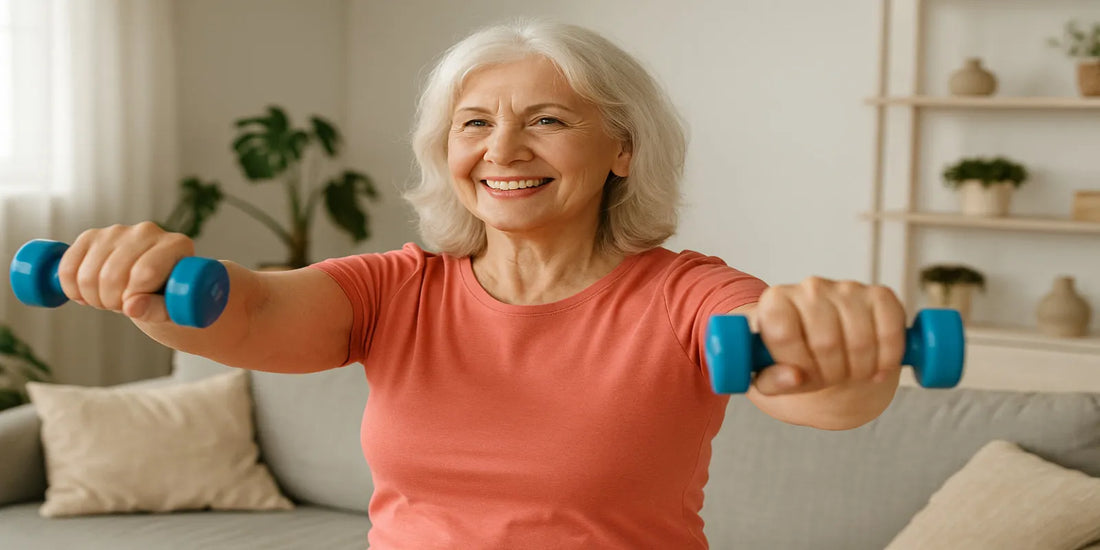
Senior Fitness Tools 2025 – 17 Easy, Safe Routines for Over 50
Share
Senior Fitness Tools 2025 – 17 Easy, Safe Routines for Over 50

Fitness after 50 should feel safe and simple. Your joints deserve kind loads. Balance needs practice. Energy rises and falls. The right tools guide good form. Short sessions help you stay consistent. This guide shows how to train at home. You need only basic gear and a calm plan. No product links are required here.
Why Senior Fitness Tools 2025 – 17 Easy, Safe Routines for Over 50 matters
Age reduces muscle mass and power. Joints may feel stiff. Balance can decline. Regular activity slows these trends. It improves function and confidence. See the National Institute on Aging overview on exercise and older adults (NIA). The CDC also recommends routine activity for heart and brain health (CDC).
We keep intensity low and progress slow. Start with ten minutes. Choose two or three tools. Move with control. Exhale on effort. Rest when form slips. Use a wall or chair for support. Safety builds confidence. Confidence builds habit. Habit builds results.
What tools will we use? A non-slip mat, light dumbbells, and elastic bands. A balance pad and a stable chair. A foam roller and a stretch strap. A low step or an indoor cycle. A timer to guide focus. These items support strength, balance, and recovery with low impact.
The full series covers seventeen easy routines. Each routine fits small spaces. Most sets use eight to ten smooth reps. Balance drills use short holds. Cardio uses the talk test. Recovery uses gentle stretches and rolling. You can adapt moves for knees, hips, or back. Clear cues will follow.
Next we start the routines. We will open with warm-up ideas, then move to strength, balance, and easy cardio. Each step favors smooth form and calm breathing.
Start strong with Senior Fitness Tools 2025 – 17 Easy, Safe Routines for Over 50

Warm up for five minutes. March in place. Circle shoulders. Hinge the hips. Breathe slowly. Keep posture tall. Hold a wall or chair if balance feels unsure.
Routine 1 — Non-slip mat flow. Cat-cow x 6. Dead bug x 6 each side. Bridge x 8. Side clamshell x 8 each. Two calm sets.
Routine 2 — Light dumbbells. Sit-to-stand x 8. Supported row x 8 each side. Wall press x 6. Two sets. Exhale on effort. Move slow.
Routine 3 — Elastic bands. Pull-apart x 8. Chest-height row x 8. Biceps curl x 8. Keep ribs down. Neck stays long. One to two sets.
Routine 4 — Chair balance. Heel-to-toe hold for 15 seconds. Repeat twice. Calf raise x 10 with light support. Train ankles and posture.
Routine 5 — Low step. Step up. Tap. Step down. Ten smooth reps each side. Keep height low. Park near a wall. Joint load stays kind.
Routine 6 — Foam roller. Roll calves, quads, and lats for 30–40 seconds. Pressure light. No bounce. Finish with two slow breaths.
Build strength and balance with gentle progress
Routine 7 — Mini-bands for hips. Band above knees. Side step x 8 each way. Repeat twice. Hips protect knees and back during daily tasks.
Routine 8 — Seated core. Sit tall. Brace the belt line. Hold five breaths. March knees x 10. Keep the spine long.
Routine 9 — Indoor cycle. Ten minutes at talk-test pace. Cadence easy. Hydrate before and after. Cycling is joint friendly.
Routine 10 — Balance pad. Single-leg stance 10–20 seconds each side. Two rounds. Eyes forward. Ankles and core learn quickly.
Routine 11 — Stretch strap. Hamstring hold 20–30 seconds each side. Chest stretch 20 seconds. No bounce. Breathe through the nose.
Routine 12 — Posture band rows. Anchor at chest height. Row x 8–10. Squeeze shoulder blades. Chin tucked. Two sets with control.
Flexibility and balance help prevent falls. The World Health Organization supports regular activity for older adults to improve function and reduce chronic disease risk (WHO).
Finish strong with Senior Fitness Tools 2025 – 17 Easy, Safe Routines for Over 50
Routine 13 — Massage ball reset. Roll feet, glutes, and shoulders. Thirty seconds each area. Gentle pressure only. Tension eases quickly.
Routine 14 — Wall slides. Back to wall. Slide arms up and down x 8. Ribs down. Shoulders glide. Two sets. Posture improves with practice.
Routine 15 — Low step intervals. 30 seconds step. 30 seconds rest. Six rounds. Keep height low. Talk easily. Stop before fatigue.
Routine 16 — Chair sit-backs. Cross arms. Tap chair. Stand tall x 8. Control the descent. Knees track forward. Add a cushion if needed.
Routine 17 — Timer focus. Set ten minutes. Pick two moves. Alternate sets. Stop fresh, not fried. Consistency builds capacity.
Weekly plan and safety checklist
Week 1–2: Two sessions per week. Ten to fifteen minutes. Pick five routines. Walk on off days. Sleep matters.
Week 3–4: Three sessions per week. Add a third set to two moves. Keep balance drills near a wall. Increase time slowly.
Always warm up. Stop with chest pain, severe breathlessness, or sudden dizziness. Review your plan with a clinician when unsure. The American College of Sports Medicine offers helpful basics for older adults (ACSM).
FAQ — My knees feel tender.
Use cycling, band rows, and seated leg raises. Skip deep knee bends and high steps.
FAQ — How long should a session be?
Ten to twenty minutes works well. Add time slowly. Form first.
FAQ — Can I train daily?
Yes, at low intensity. Rotate focus areas. Keep one full rest day weekly.
Your next step with Senior Fitness Tools 2025 – 17 Easy, Safe Routines for Over 50
Pick three routines today. Set a ten-minute timer. Move slow and steady. Log your session. Add one rep or minute next time. Small, safe steps compound.
